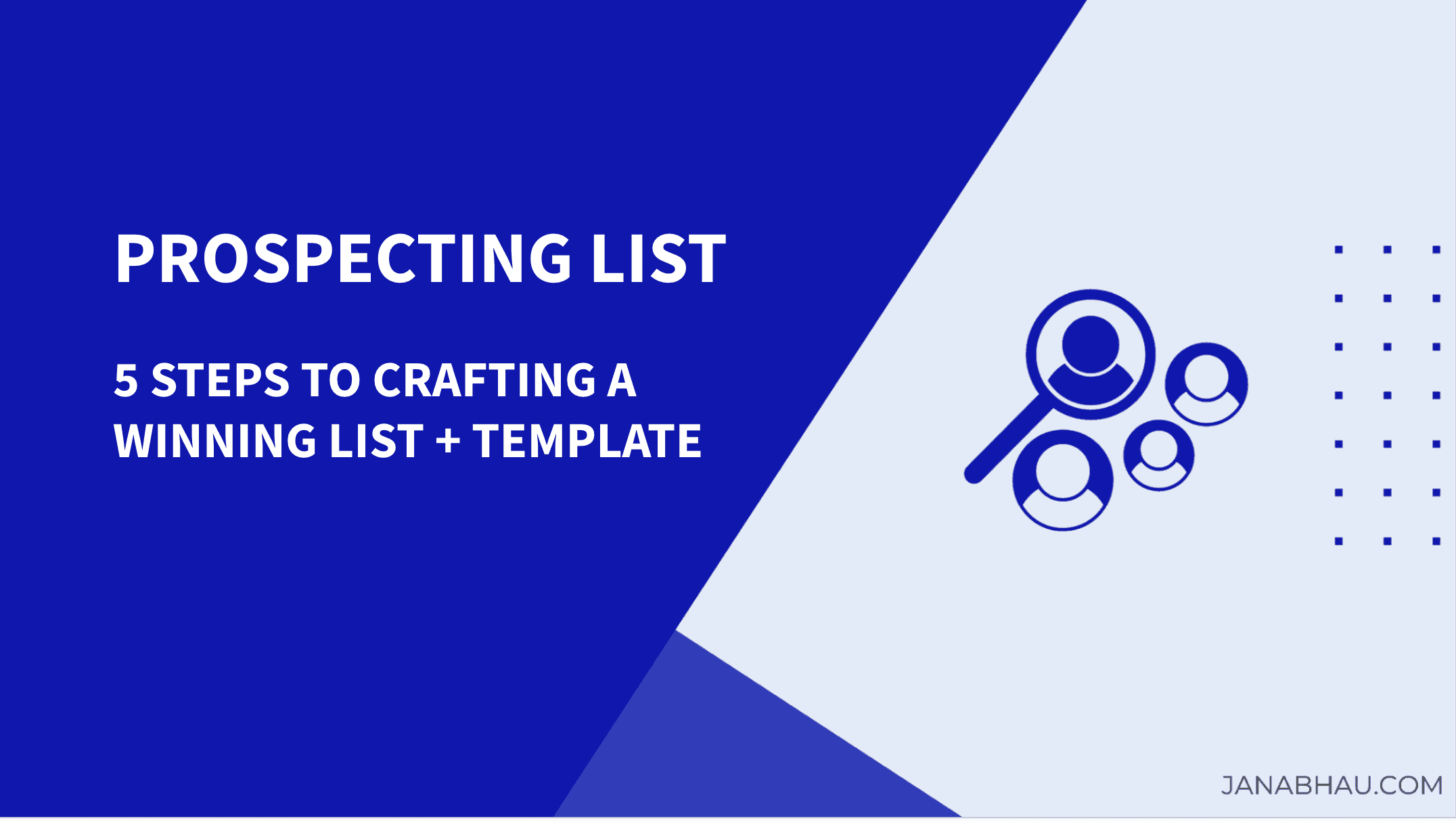How to Craft an Effective Prospecting List in 2024 [+Template]

Building an effective prospecting list is pivotal for any sales strategy. But what makes a list not just good, but great?
This article cuts straight to the chase, offering clear, actionable steps to craft a prospecting list that targets the right audience and maximizes conversion rates.
Expect to learn how to gather essential contact information, utilize advanced data points, and maintain your list’s relevance over time — all to ensure your sales outreach hits the mark, every time.
Key Takeaways
- A prospect list is a strategic assembly of potential clients fitting the ideal customer profile, essential for targeted sales efforts to convert leads into customers.
- Building an effective prospecting list requires detailed information beyond basic contact details, including company size and industry, and should be organized in a CRM for efficient engagement.
- Creating a targeted prospecting list involves understanding product use cases, defining the ideal customer profile, identifying decision-makers, and continuously updating the list for better sales conversion.
What is a Prospect List?

We begin by defining what a prospect list truly signifies. Essentially, it’s a curated compilation of individuals or businesses you want to sell your product or service to.
But it’s not just about quantity; quality is paramount. A well-constructed prospect list is not a mere collection of contacts but a strategic assembly of leads with genuine potential to convert – companies that match your ideal customer profile.
By creating targeted prospect lists, you can ensure that your sales efforts focus on those most likely to become customers.
Reasons You Need to Know How to Build a Prospecting List
Understanding how to construct a well-defined prospecting list is not just an advantage; it’s necessary to build an effective sales approach.
- Precision Targeting: Focuses your sales efforts towards individuals or businesses that fit your ideal customer profile, eliminating the inefficiency of broad, untargeted strategies.
- Efficient Allocation of Time and Money: This ensures that your time and money are invested in leads with the highest potential for conversion, optimizing your overall sales strategy.
- Better Personalization: Allows for communication tailored to the specific needs, pain points, and preferences of your prospects, enhancing the effectiveness of your outreach.
- More Informed Decisions: Transforms your prospect list from a simple collection of names into a vital source of insights, helping you prioritize accounts and create more relevant messaging.
What Information Should You Include in a Prospecting List
Creating an impactful prospecting list involves more than just names and emails. To truly supercharge your outreach efforts, you need a comprehensive set of data. Start with the basics:
- Company names
- Stakeholder names
- Roles
- Phone numbers
- Email addresses
These are the building blocks that initiate contact.
However, don’t stop there. Elevate your prospecting game by incorporating more advanced data points. Consider aspects like company size, location, industry, software they currently use, or any other insight that helps you create a more targeted approach or formulate better messaging. This layered approach not only helps tailor your outreach but also positions you as a business that understands its prospects inside out.
Step-by-Step Instructions for Building a Prospecting List
While constructing a prospecting list might appear overwhelming initially, it’s a structured endeavor that can be broken down into manageable steps. These steps, which form the sales prospecting process, involve:
- Understanding the pains your product solves
- Defining your ideal customer profile
- Organizing data in a central source
- Finding target companies
- Identifying decision-makers
We’ll dissect these steps sequentially to help you create a robust and effective prospecting list.
Step 1: Understand Pains You Solve
The initial phase in constructing a prospecting list involves comprehending the problems your product resolves. This requires an in-depth analysis of your product’s use cases and a thorough understanding of the companies that currently best use your product.
You can engage directly with customers through surveys, focus groups, and interviews to uncover their pain points. On the other hand, insights from your sales team, customer feedback from support tickets, social media, and online reviews can identify pain points that can be turned into selling points for your product.
By identifying both personal and professional pain points of customers, you can inform how your product addresses those needs and empower your sales teams.
Step 2: Define Ideal Customer Profile
Having discerned the issues your product addresses, the next step is defining your ideal customer profile (ICP). An ICP is a detailed description of a company or customer that would get the most value from your product or service. Factors to consider when defining an ICP include:
- Industry
- Company size
- Geographical location
- Customer Needs
- Deal Cycle Length
- Growth potential
Start by identifying super users among your existing customers who have traits that align with your ideal customer profile. Conduct interviews with these super users to understand:
- their buying processes
- how they discovered your product
- why they made the purchase
- how they benefit from using your product
Analyze the interview data and sales insights to detect common characteristics among your best customers, which can serve as the basis for your ICP.
Step 3: Build a Central Source

Establishing a unified source to manage and monitor prospect data is a critical step in building a prospecting list. It ensures that all your data is stored in one place and can be accessed easily. This can initially be done using a well-thought-through spreadsheet or, later on, a customer relationship management (CRM) tool that helps you store and organize information efficiently.
CRM best practices include:
- Documenting important information such as all customer interactions, meeting notes, next steps, expected deal size, and the expected date to close a deal
- Practicing list segmentation in your CRM to provide a more personalized experience to your prospects.
Step 4: Find Accounts/Companies

Finding the right companies for your prospect list is crucial. There are several ways to do this, including using the best sales prospecting tools. You can browse the web, use LinkedIn, or use paid tools like Linkedin Sales Navigator or data enrichment tools to filter and identify accounts easily.
Using a reliable B2B data provider or company database can help you search for prospects that match your criteria and prioritize your list based on intent data and sales signals. Start prospecting with smaller, better-qualified lists of target prospects to avoid wasting time on unqualified leads.
Always remember, the key is to identify the most viable prospects for your business.
Step 5: Identify Decision Makers & Add Contact Details
Having compiled a list of target companies, now’s the moment to pinpoint the right people to contact. This is where you leverage tools like LinkedIn or LinkedIn Sales Nav. Using Chrome extensions from several lead generation tools gives you instant access to contact details such as phone number and email address.
Identifying decision-makers is crucial because it ensures that your outreach efforts are directed at individuals with decision-making authority, increasing the likelihood of conversion.
Prospecting List Template

Creating a prospecting list is critical for any sales and marketing strategy, offering a structured path to identify and engage with potential leads.
To jumpstart your efforts, I’m sharing a basic prospecting list template designed to contain the essential information for each prospect. This includes details such as company name, contact name, position in the company, company size and industry, date of first and last interaction, next steps, etc.
However, this is just the starting point. It’s vital to think critically about what specific information would most benefit your unique approach and tailor your list accordingly.
Make or Buy a Prospecting List
While purchasing a prospecting list might appear enticing, but is it the best choice? Based on my experience, the answer is often no. Building your own prospecting list is more beneficial as it ensures data compliance, better targeting, and long-term strategic investment.
Legal risks of non-compliance, ineffectiveness of paid email lists, and the long-term benefits of being self-reliant are all reasons to invest time and effort in building your own prospecting list. With today’s lead gen and data enrichment tools, list building can also be significantly less time-intensive than it was in the past.
What Are the Best Prospecting Methods?
After gaining clear insights about your target audience, you have several ways to achieve that. The essential methods for prospecting include:
- Cold calling
- Partnerships
- Referrals
Each of these prospecting methods has its own strengths and can be particularly effective depending on the nature of your product and the preferences of your target audience. By effectively leveraging these methods, you can ensure that your prospecting efforts yield the desired results.
Key Considerations For Success List Building
Achieving success in list building hinges on several pivotal elements. These include critical thinking, understanding your ideal customer profile, and investing time in research and analysis. These elements form the backbone of a successful list-building strategy.
Remember, the key to successful lead generation campaigns is not just about the quantity of leads but the quality of those leads. The more targeted and personalized your list, the better your chances of converting those leads into customers.
Taking it to the Next Level: How to Increase Effectiveness of Prospecting Activities
After mastering the fundamentals of list building, it’s time to take your prospecting activities to the next level. One of the ways to increase the effectiveness of your prospecting activities is by:
- Monitoring industry news
- Monitoring social media
- Monitoring sales triggers
- Tailoring your messaging accordingly.
Platforms like LinkedIn Sales Navigator or Crunchbase offer these kinds of alerts, so you don’t have to build them yourself. By staying on top of these alerts, you can ensure you’re always one step ahead and can tailor your outreach to align with your prospects’ current needs and situations.
Wrapping Up and My Experience With Creating Prospecting Lists
Over the course of my career, I’ve developed prospecting lists and also received lists from external agencies. In almost every case, I was never satisfied with the quality of the latter. There are nuances in selecting potential customers that only you or your company can know.
Invest the time to do it yourself and everything after that will be much more effective, and results are what counts. With today’s help of lead gen and data enrichment tools and the right process in place, building a list can also be significantly less time intensive as in the past.
Frequently Asked Questions
How can I create a targeted prospecting list?
To create an effective sales prospect list, you should know your product, build an Ideal Customer Profile and Ideal Buyer Persona, understand the business’s internal organization, enhance your contact data, develop lead-generation campaigns, analyze outcomes, and refine your list. The success in creating a sales prospecting list involves:
- Understanding the pains your solve thoroughly
- Defining your ICP
- Investing in a CRM
- Researching and adding accounts
- Finding contacts with verified contact details
What is the difference between prospect list and lead list?
At the initial stage of the sales funnel, leads are positioned as unqualified contacts, indicating that they might not align with your ideal customer profile. On the other hand, a sales prospect is a potential customer who matches the ideal customer profile and demonstrates interest in your products or services. Sales reps play a crucial role in identifying and nurturing these prospects.
To put it simply, all prospects are leads, but not all leads are prospects. The key difference lies in their placement in the sales cycle and their likelihood of converting into customers.
How do I keep my prospecting list up to date?
Maintaining an updated prospecting list necessitates frequent audits and data enhancement. Consider leveraging data enrichment solutions for filling in missing data and refreshing outdated records in your prospecting list. These platforms can provide updated information to improve the quality of your leads..
It’s also crucial to regularly refresh your prospecting list and update any job changes to avoid reaching out to irrelevant contacts. Always remember, an up-to-date list is a potent tool for effective prospecting.
How can I optimize my prospecting list for better results?
Enhancing your prospecting list for superior outcomes requires several tactical measures. Start by analyzing your prospecting list for patterns or trends among successful leads. Adjust your targeting criteria, tailor your messaging to address specific needs, and continuously track and measure results for ongoing improvement.
Don’t forget to employ lead scoring to categorize leads based on factors like intention to buy, company size, and potential account value for better targeting and follow-up. Remember, the more refined your prospecting list, the more effective your outreach will be.
What is prospecting and examples?
Prospecting is the process of finding and engaging with potential leads to convert them into customers. An example of prospecting is when sales reps make cold calls, send emails, or InMails on LinkedIn to people who fit their ICP.
How do I keep my prospecting list up to date?
To keep your prospecting list up to date, regularly review and enrich your data using data enrichment solutions to fill in missing information and update outdated records. This ensures your list remains accurate and relevant.







